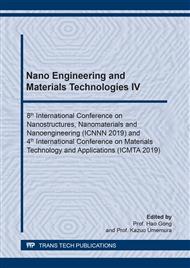[1]
V.A. Tarasov, N.A. Stepanishchev and R.P. Boyarskaya: Methods of experimental determination of the characteristic points in time of the technological process of preparing nanosuspensions under conditions of ultrasonic action, submitted to Vestnik BMSTU (2011), p.53–65.
Google Scholar
[2]
V.A. Tarasov and N.A. Stepanishchev: Plasma–powder application of antifrictional babbitt coatings modified by carbon nanotubes, submitted to Russian Engineering Research (2016).
Google Scholar
[3]
Information on https://www.us-nano.com/how_to_disperse_cnts.
Google Scholar
[4]
V.A. Tarasov and V.A. Nelyub: Rheological model of viscous incompressible fluid with disperse fillers, edited by International Journal of Mechanical Engineering and Technology (2018), pp.488-497.
Google Scholar
[5]
A.L. Galinovsky, G.F. Bethena and I.V. Petrov: Improving the performance of waterjet cutting of materials by selecting rational modes of processing by acoustic emission, edtied by metal technology (2017), p.18–27.
Google Scholar
[6]
M.L. Abashin, A.A. Barzov and A.L. Denchik: Design and technological solutions for ultra-jet processing of liquid-phase structures, submitted to Science and Technology of Kazakhstan journal (2018).
Google Scholar
[7]
V.S. Puzakov: Development and analysis of the functional capabilities of ultra-jet activation of hydrotechnological media for mechanical processing production (Vetnik BMSTU publication, Moscow 2007).
Google Scholar
[8]
B.M. Khrustalev: Dispersions of multilayer carbon nanotubes in building materials science (2014), P. 44–52.
Google Scholar
[9]
A.L. Galinovsky and A.A. Ilyukhina: Analysis of the interconnectedness of the functional-physical capabilities of additive and ultra-jet technologies edtied by Fundamental and applied problems of engineering and technology (2018), p.73–81.
Google Scholar
[10]
V.A. Tarasov and V.D. Baskakov: Mathematical modeling of the collision process of flat jets of an ideal fluid, sumitted to Vestnik BMSTU, Moscow (2016), p.79–90.
Google Scholar


